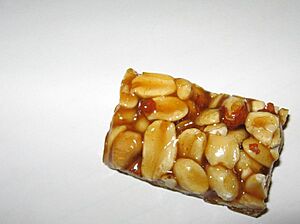Pé-de-moleque facts for kids
Pé-de-Moleque (pronounced "peh-jee-moh-LEH-kee") is a super yummy and traditional candy from Brazil! Its name literally means "brat's foot" in Portuguese. It's made mainly from peanuts and a special kind of brown sugar called rapadura or sometimes molasses.
The candy is prepared by mixing roasted, peeled peanuts with melted brown sugar. Sometimes, crushed peanuts are also added to the mix. This sweet mixture is gently stirred over low heat until it starts to get thick. Then, it's placed in pieces on a flat stone or metal surface, often lightly oiled with butter. Each piece is about the size of a cookie. This traditional way of making it results in soft, dark brown sweets that don't have a perfect shape. They are soft because of the natural oil from the peanuts.
Contents
Where Did Pé-de-Moleque Come From?
Pé-de-Moleque first appeared in Brazil around the middle of the 16th century. This was when sugar cane was brought to the country.
The city of Piranguinho, located in the south of Minas Gerais state, is very famous for making these sweets by hand. Piranguinho is known across Brazil for its big party celebrating the "biggest pé-de-moleque in the world"! This fun event is a special part of the city's yearly celebrations.
Other Names Around the World
This delicious peanut candy is known by different names in other countries:
- In India, especially in the states of Gujarat and Maharashtra, it's called chikki.
- In Portugal, a similar candy is known as nougat.
- In Mexico, it's called palanqueta.
There's also a special version of Pé-de-Moleque that's made into a cake. This cake is very popular during Festa Juninas, which are traditional festivals in the Northeast of Brazil. This Pé-de-Moleque cake is also called "bolo preto" (which means "black cake"). Sometimes, cashew nuts are used instead of peanuts, and it always includes rapadura and fermented cassava dough, along with other ingredients.
What Does the Name Mean?
The name "pé-de-moleque" has two interesting ideas about where it came from:
- One idea is that the candy's irregular shape looks like the old, bumpy stone paths found in historic Brazilian cities. These paths were also called "pé-de-moleque." You can see them in places like Paraty and Ouro Preto.
- Another story says the name came from street vendors long ago. These vendors sold the candy, and kids would sometimes try to steal it. To stop them, the vendors would tell the boys to just ask for it instead of stealing. They would say:
* "Pede, moleque!" (which means "Ask for it, kid!").
Pé-de-Moleque in Books
This sweet candy has even been mentioned in books!
- In the book O dialeto caipira by Amadeu Amaral, there is a mention of "pé-de-moleque."
- In 1983, a famous Brazilian poet named Carlos Drummond de Andrade called pé-de-moleque the "pure jewel of Minas Gerais." He even sent a text about it to one of the bakers in Piranguinho!


